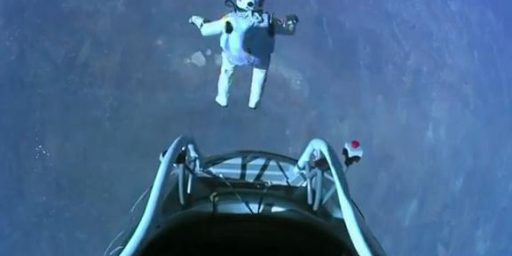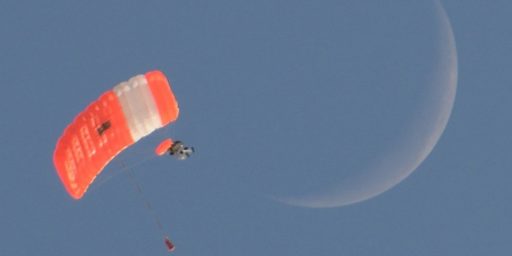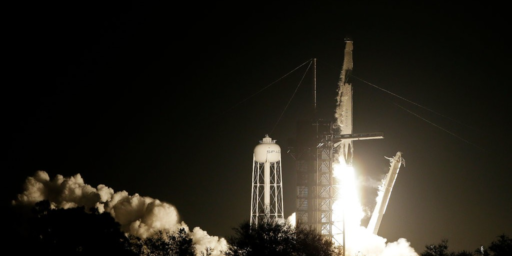Felix Baumgartner Attempting Skydive From 23 Miles Above Earth
Just about 11:30 this morning Eastern time, a balloon carrying a capsule started ascending over the New Mexico desert. Inside that capsule is Felix Baumgartner, an Austrian skydiver, Base Jumper, and all around daredevil, who is going to attempt to jump from a higher altitude than any human being ever has:
ROSWELL, N.M. — Felix Baumgartner, the professional daredevil, took off for the stratosphere on Sunday, lifting off in an enormous helium balloon that smoothly carried him through the critical first 4,000 feet — called the Dead Zone because it would be impossible to parachute to safety.
He reached 40,000 feet after 34 minutes and planned to ascend to more than 120,000 feet — 22 miles above the New Mexico desert — where he hoped to make the highest jump in history and become the first sky diver to break the speed of sound. The ascent should take at least two hours.
During the ascent, Mr. Baumgartner went through a checklist with help from Joe Kittinger, 84, the retired Air Force colonel who in 1960 jumped from 102,800 feet, setting records that remained more than half a century later — and that Mr. Baumgartner was hoping to break.
“Be sure to stay hydrated, Felix,” Mr. Kittinger said as the capsule rose above 22,000 feet. “You’re doing great on that altitude.”
The mission requires the largest balloon ever used for a manned flight. Made of 40 acres of ultrathin plastic, it has been described as an inflated dry-cleaning bag that would fill the Los Angeles Coliseum.
When inflated and attached to Mr. Baumgartner’s pressurized capsule, the balloon towered 750 feet above the ground. The winds at that level and at the ground had to be less than three miles an hour for it to be launched safely, so that there was no chance of the balloon lurching and smashing the capsule into the ground.
Mr. Baumgartner, wearing a pressurized suit to survive in the near vacuum at the edge of space, planned to step off the capsule above 120,000 feet and quickly break the sound barrier, reaching a speed of more than 700 miles an hour. He expected to free-fall for five and a half minutes before deploying his parachute a mile above the ground.
Mr. Baumgartner was backed by a NASA-style mission control operation at an airfield in Roswell that involved 300 people, including more than 70 engineers, scientists and physicians who have been working for five years on the project, called Red Bull Stratos, after the drink company that has financed it.
While building the customized suit and capsule, the team of aerospace veterans had to contend with one crucial uncertainty: What happens to the human body when it breaks the sound barrier? There was also one major unexpected problem for Mr. Baumgartner, 43, an Austrian daredevil and former paratrooper known to his fans as Fearless Felix.
Although he had no trouble jumping off buildings and bridges, and across the English Channel in a carbon-fiber wing, he found himself suffering panic attacks when forced to spend hours inside the pressurized suit and helmet. At one point in 2010, rather than take an endurance test in it, he went to an airport and fled the United States. With the help of a sports psychologist and other specialists, he learned techniques for dealing with the claustrophobia.
Besides being his most complex challenge, the stratospheric jump is also the one most likely to be made into a buddy movie, thanks to the friendship that he developed with Mr. Kittinger, who helped train Mr. Baumgartner.
Mr. Kittinger, a former test pilot, set his records in a 1960 trip to the stratosphere. Early during that ascent, also over New Mexico, in an Air Force balloon, one of his pressurized gloves leaked, but he was so determined to keep going that he did not report the problem even after his hand swelled to twice its normal size.
Ignoring the pain, he rode the balloon up to 102,800 feet and said a short prayer — “Lord, take care of me now” — before stepping off. He reached a speed of 614 miles an hour and spent 4 minutes, 36 seconds in free fall. Those records were repeatedly challenged during the ensuing half century, sometimes with fatal consequences.
Besides aiming at records, the engineers and scientists on the Red Bull Stratos team are gathering and publishing reams of data intended to help pilots, astronauts and perhaps space tourists survive if they have to bail out.
“We’re testing new spacesuits, escape concepts and treatment protocols for pressure loss at extreme altitudes,” said the Red Bull Stratos medical director, Dr. Jonathan Clark, who formerly oversaw the health of space shuttle crews at NASA. “There are so many things that could go wrong here that we’re pushing the technical envelope.”
The original stratospheric jump by Mr. Kittinger was part of an Air Force program studying ways to help pilots survive high-altitude bailouts. It experimented with a small parachute, called a drogue, to prevent the jumper’s body from going into a flat spin — a hazard that almost killed Mr. Kittinger in a preliminary jump in 1959. When his drogue chute became entangled around his neck, his body spun at 120 revolutions a minute, causing him to blackout until his emergency parachute automatically deployed. An improved version of that drogue chute is now used by military pilots who have to bail out in the ejection-seats used by pilots.
As I type this, the capsule is at approximately 78,000 feet and has passed the point where, without a pressurized suit and/or a pressurized cabin, a human being could not survive because all the fluids in their body would boil away due to the air pressure. At the rate they’ve been going, they’ve got about another hour to go before they reach the 120,000 foot level. After that, it quite obviously will take Baumgartner not quite as much time to return to Earth.
The Discovery Channel is covering the ascent and, of course, the descent, live as week speak, or you can watch it via this live online stream:
Update: Baumgartner was successful. Jumped from 128,000 feet and landed on his feet. Details to come in a subsequent post.
H/T; Jazz Shaw







Why care?
@PJ:
Some things should be done just because they push the absolute limits of human technology, endurance, and perseverance.
Also, it’s awesome.
I look forward to hearing how it felt. The subjective matters in something like this.
(Geez, I’d do this before I’d do space tourism. This would rock all over a mere visit to the space station.)
@PJ:
I understand someone in Dayton, Ohio said that to the Wright brothers in 1902
@Doug Mataconis:
Yes, because doing a jump from 128,000 feet is just the same as what the Wright brothers did.
And it’s just as important for the future, because now, if Mitt Romney is in a burning airplane, he can now just leap out of it thanks to what we learned today!
I’m sure you thought that you said something profound, but you did not. Rephrase.